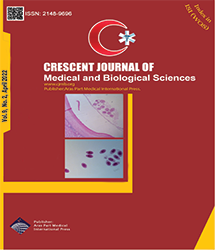
| Original Article | |
| Evaluation of the Effects of Bunium persicum and Albendazole on Killing Hydatid Cyst Protoscolices In Vitro | |
| Yagoob Garedaghi1, Patrice Bouree2,3, Arash Khaki4, Faezeh Shaarbaf5, Mehrnaz Haji Abedin Rangraz6 | |
| 1Department of Parasitology, Faculty of Veterinary Medicine, Tabriz Medical Sciences, Islamic Azad University, Tabriz, Iran 2Tropical Department, Institute Alfred Fournier, 75014 Paris, France 3Department of Infectious Diseases, Hôtel-Dieu Hospital, Paris, France 4Department of Pathology, Faculty of Veterinary Medicine, Tabriz Medical Sciences, Islamic Azad University, Tabriz, Iran 5Department of Biology, Faculty of Science, Ferdowsi University of Mashhad, Mashhad, Iran 6Department of Development and Cooperation of Information and Science Publication, Undersecretary for Research and Technology, Ministry of Health and Medical Education, Tehran, Iran |
|
|
CJMB 2022; 9: 089-092 DOI: 10.34172/cjmb.2022.15 Viewed : 3158 times Downloaded : 2271 times. Keywords : Hydatic cyst, Effects, Albendazole, Bunium persicum, In Vitro |
|
| Full Text(PDF) | Related Articles | |
| Abstract | |
Objectives: Hydatidosis is a parasitic disease of zoonoses and the best treatment for this parasitic disease is cryosurgery. From time immemorial, many protoscolice-destroying chemicals have been used to inhibit the distribution of protoscolices within the cyst during surgery. However, the side effects of chemical compounds and medicinal plants should always be considered. Due to the antiparasitic properties of Bunium persicum (Boiss), this study was performed to evaluate and compare the effects of B. persicum (Boiss) essential oil and albendazole on protoscolices inside hydatid cyst in vitro. Materials and Methods: In this study, the essential oil used from the desired plant seeds was prepared. Gas chromatography-mass spectrometry was performed to determine its components. Hydatid cyst protoscolices were extracted from hydatid cyst-infected livers and exposed to B. persicum (Boiss) (2.5, 5, and 10 μg/mL) for 10, 30, 60, and 120 minutes, respectively. The viability of protoscolices was measured by the effect of plant essential oil by eosin staining. Albendazole was also used as an effective antiparasitic drug in this study. Results: The amount of essential oil protoscolices at 2.5 μg/mL in 10, 30, 60, and 120 minutes was 48.5%, 68.2%, 79.5%, and 96.1%, respectively. The antiparasitic drug albendazole showed less toxic effects at similar doses at the same intervals, but both treatment groups had a significant effect (P<0.001). The highest toxic effects of essential oil were observed at a concentration of 10 μg/mL 30 minutes after treatment. For albendazole, this effect was achieved at a dose of 10 μg/mL after 2 hours. Conclusions: The results and statistical data of this study showed that the essential oil of B. persicum (Boiss) in comparison with the antiparasitic drug albendazole has an acceptable scolicide effects in hydatidosis and can be used as an alternative to scolicide compound. |
Cite By, Google Scholar
Google Scholar
PubMed
Online Submission System
 CJMB ENDNOTE ® Style
CJMB ENDNOTE ® Style
 Tutorials
Tutorials
 Publication Charge
Medical and Biological Research Center
About Journal
Publication Charge
Medical and Biological Research Center
About Journal
Aras Part Medical International Press Editor-in-Chief
Arash Khaki
Deputy Editor
Zafer Akan



















